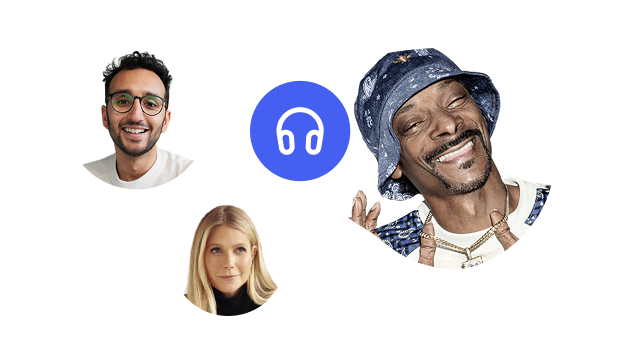For people living with ADHD, everyday tasks that seem simple, such as reading a report, finishing a chapter, replying to emails, can feel like running a mental marathon. Concentration slips, motivation fades, and what starts as determination often ends in distraction. The ADHD brain isn’t lazy or incapable, but rather it’s wired for creativity, speed, and innovation, yet struggles with the monotony and sustained attention traditional reading requires. That’s where AI voice technology can make a difference. In this article we’ll explore everything you need to know about how AI voice can help people with ADHD.
How AI Voices Help ADHD
By turning written text into realistic AI voices, text to speech tools help people with ADHD absorb information faster, focus longer, and complete more tasks with less frustration. Listening, rather than reading, engages the ADHD brain’s need for stimulation and variety while reducing the mental friction that makes reading so draining.
Understanding ADHD and the Reading Struggle
Attention-Deficit/Hyperactivity Disorder affects focus, working memory, and executive functioning, which are the mental skills that allow a person to organize, plan, and follow through. Reading often becomes one of the biggest challenges because it demands quiet, stillness, and sustained visual focus, which conflict with how ADHD brains naturally operate. After a few paragraphs, attention fades, the mind wanders, and comprehension drops. The result is frustration, avoidance, and often self-blame.
Text to speech technology changes that dynamic. Instead of requiring intense concentration, TTS allows users to listen, engaging the auditory centers of the brain and creating a more natural, less stressful way to process information. When sound replaces silent reading, comprehension improves, attention steadies, and learning becomes more accessible.
The Challenges of ADHD and How AI Voice Can Help
Living with ADHD often means battling distractions, forgetfulness, and mental overload, but AI voice tools are transforming how people with ADHD focus, learn, and stay organized. Here’s how AI voices can help the challenges of ADHD, so you can succeed.
Short Attention Span and Wandering Focus
For many with ADHD, focusing on long stretches of text is nearly impossible. Static words on a screen or page don’t provide the stimulation the brain craves, leading to zoning out mid-sentence. Text to speech counteracts that by engaging auditory processing. Listening to human-like AI voices activate different neural pathways than reading, keeping attention anchored for longer periods. The rhythm, tone, and pacing of a natural voice provide gentle stimulation that helps the ADHD brain stay alert. When users can also control playback speed,speeding up during high-energy moments or slowing down when attention dips, they regain control over how they process information. AI voices turn reading from a visually exhausting chore into an active, sensory experience that holds focus and builds comprehension.
Difficulty Starting Tasks (Executive Dysfunction)
One of the most frustrating ADHD symptoms is task initiation paralysis—the feeling of wanting to begin but being unable to. Long documents or dense materials can feel like insurmountable mountains, triggering avoidance. Text to speech helps by eliminating that initial barrier. Instead of facing a daunting wall of text, users can simply press “play.” The AI voice starts reading instantly, giving them a quick win and a sense of progress. Once the audio begins, momentum takes over and motivation increases naturally. By making that first step effortless, AI voice tools transform the hardest part—getting started—into something automatic. That gentle push helps ADHD users overcome inertia and move into a steady rhythm of focus and completion.
Reading Fatigue and Information Overload
People with ADHD often describe mental burnout after trying to read for long periods. Concentration collapses, details blur, and comprehension fades. This fatigue leads to information overload, where even short tasks feel unmanageable. AI voice technology provides relief by converting long readings into accessible audio. Listening reduces the visual strain that drains mental energy and allows for breaks without losing track of content.
Poor Working Memory and Retention
Many people with ADHD struggle to remember what they’ve just read, even when they’ve been trying to focus. This weak working memory makes it hard to retain important details. Text to speech strengthens memory by activating both auditory and visual channels simultaneously. Hearing words read aloud adds rhythm and emotion, making the content more memorable than silent reading. Users can easily replay sections for reinforcement or follow highlighted text visually, reinforcing comprehension through repetition.
Restlessness and Need for Movement
The ADHD brain often focuses best when the body is moving. Unfortunately, reading traditionally requires stillness, which can make it difficult to sit through long sessions. AI voice technology enables movement without losing focus. Users can listen to their readings while walking, cleaning, exercising, or commuting, channeling physical restlessness into productive listening. This combination of motion and information processing stimulates dopamine levels in the brain, helping improve concentration naturally. Turning reading into a mobile activity gives ADHD users the freedom to learn or work in environments that match their energy levels. Rather than fighting their need for movement, they can lean into it—and still get things done.
Disorganization and Missed Deadlines
Disorganization is one of ADHD’s defining struggles. Important emails go unread, meetings are forgotten, and deadlines sneak up unexpectedly. Text to speech tools bring structure and automation to these daily challenges. By converting written reminders, notes, and messages into AI voices, users can stay updated without having to stop and read. Listening instead of reading keeps vital information top of mind and helps ADHD users stay organized, aware, and on schedule.
Speechify: An ADHD AI Voice Platform
Speechify stands out as one of the most ADHD-friendly tools because it’s designed to do more than just read aloud. It enhances understanding, focus, and productivity through AI features. With 1,000+ realistic AI voices in 60+ languages, adjustable playback speeds, and word highlighting, it keeps attention anchored through sight and sound. Speechify’s AI Summaries condense long texts, while AI Chat and AI Quiz turn listening into active learning—helping users process, retain, and organize information with less effort and more confidence. Together, these features help ADHD users reclaim their attention, stay organized, and feel empowered in both work and daily life.
Listening is the New Reading for the ADHD Mind
For the ADHD brain, silence isn’t focus and stillness isn’t productivity. Reading line after line of text can be draining, but listening transforms that experience into something manageable and even enjoyable. AI voice technology empower people with ADHD to learn, work, and organize their lives on their own terms.
Speechify leads this technology by combining realism, adaptability, and intelligence into one seamless tool. It doesn’t just read—it teaches, engages, and supports the way ADHD brains work best. For millions of people, it’s proof that success isn’t about forcing focus—it’s about finding smarter ways to harness it.
FAQ
How does Speechify help people with ADHD focus?
Speechify turns text into AI voices that stimulates auditory attention and minimizes visual fatigue, helping users maintain focus for longer periods.
Can Speechify help students or professionals with ADHD?
Yes. Students can use it to listen to textbooks or class notes, while professionals can absorb reports, emails, or meeting transcripts on the go.
Does listening really improve memory for ADHD users?
Absolutely. Listening activates auditory and emotional memory, helping ADHD users retain and recall information more effectively.
Is Speechify easy to use across devices?
Yes, Speechify syncs automatically between mobile, desktop, and browser, allowing continuous, flexible listening anywhere.
What makes Speechify better than other text to speech apps for ADHD?
Its AI summaries, quizzes, and lifelike voices make Speechify uniquely effective for ADHD users who need stimulation, structure, and support in one place.





